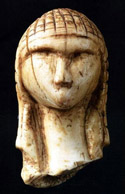Anthropology, Department of
Document Type
Article
Date of this Version
1995
Abstract
In the 1960s, several practitioners (James Deetz, James Hill, William Longacre, and Robert Whallon) of what was eventually called the "New Archaeology" used ceramic stylistic elements to support claims about the postmarital residence of prehistoric populations. In particular, Hill and Longacre argued for two post-A.D. 1000 pueblos in Arizona that the observed lack of variation in ceramic stylistic elements was owed to the practice of matrilocal residence. Anthropologically informed common sense grounded their assumptions that females, schooled by their mothers, were responsible for ceramic production. These interpretations especially the under-supported assumptions---were criticized on many counts.



Comments
Published in American Antiquity 60:3 (July 1995), pp. 578-579. Copyright 1995 Society for American Archaeology. Used by permission.